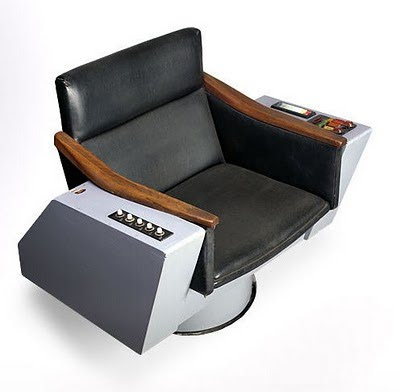Yes, I am aware that this attests to my age.
The original Star Trek ran for only 3 seasons (1966 to 1969) but lived on in reruns - eventually developing a strong following that included me as a teenager. The show's main cast of characters included Captain James T. Kirk, Mr. Spock, "Bones" McCoy, and Scotty the chief engineer. The sinister Klingons were always lurking somewhere in the shadows of deep space. Ubiquitous lines attributed to those early episodes often include: "Beam me up, Scotty", "Phasers on stun", and "Illogical, Captain".

Captain Kirk's chair on the bridge of the Starship Enterprise was a prop that was seen in almost every episode, and there was something about it that I always found fascinating. I remember thinking that some lucky dude must have had the coolest job in the world to be designing and building that thing.
Recently I came across an online article which described this chair as the most expensive piece of "Star Trek: The Original Series" memorabilia ever sold at auction. It realized a final sales price of $304,750 (on a bid of $265,000) as Lot 175 in the historic Profiles In History Bob Justman Star Trek Auction held June 27th, 2002 in Los Angeles, CA.
The Profiles auction catalog description provided some interesting construction insights, exact dimensional information, and what were at-the-time previously unseen photos of its current condition. The significant technical portion of the essay is reproduced below:
175. COMMAND CHAIR AND PLATFORM FROM THE “U.S.S. ENTERPRISE”. The original Captain’s Chair from the bridge of the legendary starship, U.S.S. Enterprise. Constructed at the Desilu Culver Studios in November of 1964, this world-renowned chair was first used by actor Jeffrey Hunter as Captain Christopher Pike in the first pilot, The Cage, and remained the focal point of the bridge throughout the entire series as Captain James T. Kirk’s seat of command.
The original design for the bridge was the responsibility of Art Director Pato Guzman and Set Designer Walter “Matt” Jefferies (after the first pilot, Jefferies became the Art Director throughout the entire series). Although construction of the Enterprise sets was an orchestrated team effort, Special Effects Supervisor Jim Rugg and Matt Jefferies were the two primary people involved in its design and construction.
The outer block-frame of the chair is crafted from plywood and painted battleship grey in color. The wide-spaced armrests contain the controls and switches used by Capt. Kirk to engage various functions of the starship. Set within the frame is the original Naugahyde-covered seat with stained wooden armrests.
The chair is mounted on a wooden pedestal base that features a spring-loaded swivel which centered the chair after the Captain rose from it on either side. The rectangular base of the chair is covered in the original Ozite ® carpet which covered the entire floor of the Enterprise bridge.
The left arm control panel and switches remain as they appeared on the final episode, Turnabout Intruder. [More than once, the special effects crew changed the composition and layout of the control panels to adhere to script requirements.] On the right arm control panel, the owner reinstalled the original five white-button control unit.
Four ceramic, 25-watt light sockets, surrounded with tinfoil to protect the encircling wood from the heat, are mounted in a space beneath the control panel. The base of the chair holds a power cord wired to the sockets which, when powered, would illuminate the colored epoxy resin buttons and switches (one of the epoxy resin “lights” is missing).
The base of the chair is 42 in. wide x 35 in. deep, and stands 9 ¼ in. height. The chair itself is 39 in. wide (from arm to arm), with a 25 ¾ in. tall backrest. The seat of the chair rises 14 in. from the bottom of the base.
The late owner picked up the chair and accompanying set pieces (Lots. 176-183) in 1969 after he received a call from a friend at Paramount Pictures, who alerted him to the fact that the entire Star Trek set was being scrapped and that, if he was interested, he was welcome to get whatever items he wanted before they were thrown away.
A true icon of entertainment history, the Captain’s Chair is visible in literally every single episode of this beloved, legendary series and is, without question, one of the most important discoveries in the history of television memorabilia, and arguably the most recognizable chair in the world.
Is it really!
ReplyDeleteLooking fantastic in design. I just want to sit on this chair. This is amazing in style.